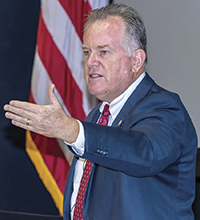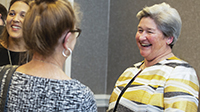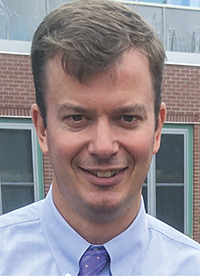An Evolution in K-12 School Accreditation
August 01, 2020
In a quest for relevance, regional accrediting bodies move away from counting school library books to plotting paths for continuous growth

Gregory Franklin, a superintendent in Orange County, Calif., has played an instrumental part in the formal accreditation process that for more than a century has been holding schools accountable to standards driven by the priorities of the day, from counting
books stocked in the school library to ranking schools by standardized test scores to today’s focus on building capacity for continuous improvement.
Speaking to the impact of accreditation, Franklin recounts a case involving a “very
large public high school in California that was really letting its kids down. … You could have pointed in every direction and found someone to blame. The instruction was poor, the leadership was poor and there was a lot of labor strife.”
The visiting peer review team documented these deficiencies in its accreditation report for the Western Association of Schools and Colleges, something the school district should have addressed in its own self-analysis, Franklin says, “but
sometimes dysfunction gets in the way of that.”
A year later, the peer reviewers, including Franklin, returned to find most of the school’s leadership and some key faculty leaders had been replaced and a facilitator had been
brought in “to get everybody rolling in the right direction,” says the superintendent since 2011 of the 24,000-student Tustin, Calif., Unified School District. “I’m certain that improvement would not have happened without the
accreditation process.”
This Content is Exclusive to Members
AASA Member? Login to Access the Full Resource
Not a Member? Join Now | Learn More About Membership

George Edwards remembers the first time he went on a school accreditation peer review visit as headmaster of a high school in New Hampshire that was beginning its own accreditation process with a self-reflection review.
“I called the
New England Association for Schools and Colleges and volunteered to be a visitor,” says Edwards, now director of the regional body’s Commission on Public Schools. “I really enjoyed that first visit. It was good professional development,
and I liked giving back and helping other schools improve.”
The multiday peer review visit is the core of the accreditation process, the step that follows the school’s comprehensive self-study. The accrediting commission uses the
examiners’ on-site observations along with the self-examination to decide whether accreditation is warranted, denied or approved with stipulation.
Personal Benefits
The four major accreditation bodies that
review elementary and secondary schools rely on experienced educators to serve on the peer review panels whose members typically spend two to four days visiting schools and talking to students, teachers, parents and administrators. The host organization
is responsible for site-visit expenses but not for the time of peer reviewers, who volunteer their services.
“It’s been said it’s the best professional development you can get,” says Barry Groves, a former superintendent
in California who now works as president of the Western Association of Schools and Colleges Accrediting Commission for Schools, which manages accreditation for 98 percent of the schools in California and Hawaii. “You visit schools and learn the
neat things they’re doing. I’m naturally a teacher, so I loved working with the schools to share ideas and see their options they have for school improvement.”
Lisa McCauley is president of the Middle States Association Commissions
on Elementary and Secondary Schools, which handles accreditation in a region that historically ran from New York to Delaware but now includes 39 states. McCauley says she believes in the powerful value of peer reviews for all parties.
Self-study
reviews by teachers and administrators take up to 18 months, and “many schools are very hard on themselves,” McCauley says. The peer reviewers often point out the positives of what they’ve seen, along with the challenges. “That’s
what growth is,” she adds. “That’s improvement.”
Balanced Pictures
With thousands of trained, volunteer peer reviewers, the process allows for a “balanced, objective and apolitical”
review of improvement efforts while building the capacity for change, says Mark Elgart, president and CEO of Cognia, which accredits more than 25,000 schools and education institutions nationwide.
“This a benefit of accreditation,”
Elgart says. “We don’t just focus on what they’re not doing. We identify what they’re doing well and encourage them to keep doing that. We identify where they need improvements and give them direction.”
Accrediting agencies
use their membership pools to secure peer reviewers, says Edwards, who has served more than 30 times as a reviewer, giving “context and perspective” to educators who often “are very isolated in their work.” Being a peer reviewer,
he adds, “gives you an opportunity to see how another school in another community educates their students.”
School system administrators interested in serving as peer reviewers should contact their accreditation agency.
Click here to see the directory.

PHOTO COURTESY OF FALMOUTH. MAINE, PUBLIC SCHOOLS
The coastal Maine community of Falmouth runs a school system considered well above average on state standards, and Forbes magazine once named it a “Top City to Live and Learn.”
But to superintendent Geoff Bruno, the three schools
in the Falmouth district often acted as separate entities, despite their location at the same address. He recognized the lost opportunity for synergy to make the learning experiences even better for the 2,200 students.
To commence that process,
Bruno turned to the external reviewing agency that had accredited Falmouth High School since 1955: the New England Association of Schools and Colleges. But that had carried its own frustrations.
“The challenge for us is that when the
high school would go through its own two-year self-study, it was like they dropped off the face of the earth,” Bruno says. “All three schools are on one campus, and I started to consider going through accreditation as a whole school community.”
A Unified Study
That led the superintendent to contract with the New England accrediting body to undertake a districtwide accreditation process, making Falmouth the first district-level review in the six-state NEASC
region. The process, beginning in spring 2018, applied one set of standards across Falmouth’s elementary, middle and high schools.
Falmouth engaged in a unified study of self-reflection and assessment with a committee composed of students,
teachers, parents, administrators, school board members and other community members. Asked to consider the “vision of a graduate,” they examined the schools’ pursuit of such goals as college and career readiness and social and emotional
well-being, according to George Edwards, who directs the accreditation agency’s Commission on Public Schools.
“It’s not just teachers in grades 9 through 12 collaborating on accreditation,” says Bruno, superintendent
since 2014 in the suburb north of Portland. “It’s also your elementary and middle school staffs, and that’s really powerful.”
After Falmouth completed its self-study, NEASC staff and trained peer reviewers assembled
as the six-member collaborative conference visiting team. Over two days in February 2019, the examiners watched classroom instruction and met with students, parents, teachers and school leadership to share observations and evidence before they summarized
findings and recommendations in a report to the Falmouth school board in May 2019.
NEASC issued full accreditation standing to the district.
Connective Strategies
Falmouth uses the accreditation report
to guide professional development and continuous growth. Teachers and principals address the newly adopted New England agency’s standards for learning culture, student learning, professional practices, learning support and learning resources.
This systemic perspective, from elementary through high school “unifies your approach,” Bruno says. “It gave us a framework for fleshing out real priorities that play out differently in each school, yet pointed out also those
things we need to keep coming back to as a district.”
Although some states and regional agencies confer accreditation on the district itself, NEASC’s approach is to “accredit every school in the process, so it’s districtwide
in that respect,” says Cameron Staples, NEASC’s chief executive. “The real key for us is connecting [school improvement] strategies from one school to another. Starting with smaller districts, we’re looking at ways to apply that
to larger ones.”
Formerly known as AdvancED, includes the North Central Association Commission on Accreditation and School Improvement, the Northwest Accreditation Commission and the Southern Association of Colleges and Schools Council on Accreditation and School Improvement. Cognia also accredits schools outside these regions and worldwide.
PUBLIC SCHOOLS/INSTITUTIONS ACCREDITED
18,135 total number of schools
- 5,004 high schools
- 2,708 middle schools
- 8,129 elementary schools
- 65 education service agencies
- 909 districts with districtwide accreditation
Middle States Association Commissions on Elementary and Secondary Schools
Historic coverage area includes New York, New Jersey, Pennsylvania, Delaware, Maryland and Washington, D.C., but accredits schools in 39 states, Puerto Rico and the U.S. Virgin Islands.
PUBLIC SCHOOLS/INSTITUTIONS ACCREDITED
459 total number of schools
- 36 elementary and middle schools
- 18 middle schools and high schools
- 64 elementary schools
- 33 middle schools only
- 225 high schools only
- 6 Pre-K–12 schools with postsecondary programs
- 15 districts with districtwide accreditation
New England Association of Schools and Colleges Commission on Public Schools
Historic coverage area includes Connecticut, Maine, Massachusetts, New Hampshire, Rhode Island and Vermont. Also accredits overseas.
PUBLIC SCHOOLS/INSTITUTIONS ACCREDITED
725 elementary, middle, high and career and technical/vocational schools
Western Association of Schools and Colleges’ Accrediting Commission for Schools
Historical coverage area includes California and Hawaii. Accredits about 98 percent of the schools in California and Hawaii. Also has a national and global footprint.
PUBLIC SCHOOLS/INSTITUTIONS ACCREDITED
5,020 total number of schools
- 2,451 high schools
- 282 middle schools
- 1,070 elementary schools
- 3 districts with districtwide accreditation
Author
Advertisement
Advertisement
Advertisement
Advertisement



